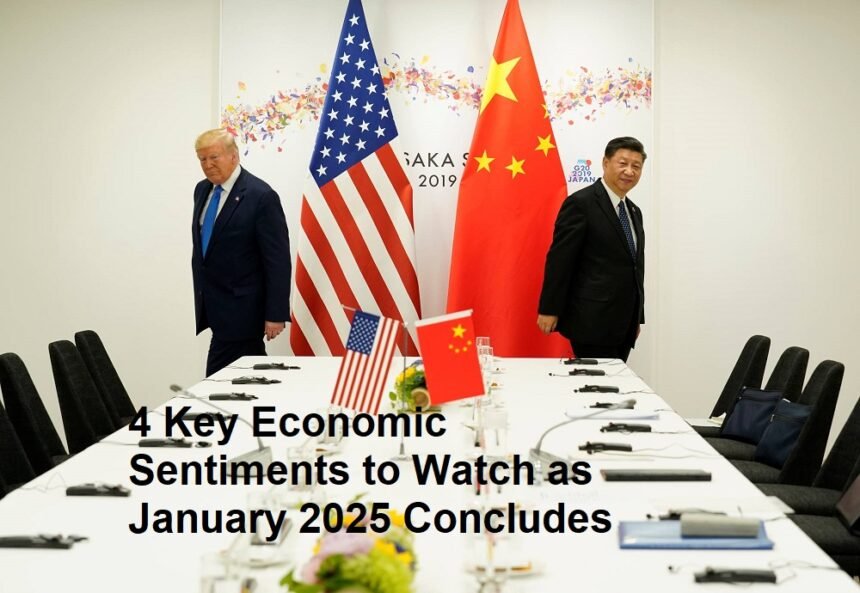As January 2025 draws to a close, global markets and policymakers are navigating a complex economic landscape shaped by lingering post-pandemic adjustments, geopolitical tensions, and transformative technological shifts. From inflationary pressures to climate-driven policy reforms, here are the four critical economic sentiments dominating discussions among analysts, investors, and governments worldwide.
- Inflation and Central Bank Policy Pivot Watch
Current Snapshot:
Global inflation, which peaked at 9.8% in mid-2023, has cooled to an average of 3.5% in advanced economies. However, uneven declines in food and energy prices—exacerbated by climate disruptions and supply chain bottlenecks—keep central banks cautious.
Key Developments:
- Federal Reserve’s Dilemma: The U.S. Federal Reserve faces pressure to cut rates after maintaining a 5.5% benchmark since July 2023. While U.S. inflation dipped to 2.9% in December 2024, robust labor markets (unemployment at 3.8%) complicate the timing of easing.
- ECB’s Green Transition Focus: The European Central Bank has linked rate cuts to progress in decarbonizing industries, a strategy criticized for mixing monetary policy with climate goals.
- Emerging Markets: Countries like Turkey and Argentina remain vulnerable to currency volatility, with inflation still above 30%.
Expert Insight:
“Central banks are walking a tightrope. Premature cuts could reignite inflation, but delays risk stifling growth in debt-laden economies.”
—Carmen Reinhart, Chief Economist, World Bank
- Geopolitical Risks: U.S.-China Tech Wars and Middle East Instability
Escalating Tensions:
- Semiconductor Showdown: U.S. restrictions on advanced AI chip exports to China have intensified, prompting Beijing to accelerate its $150 billion semiconductor self-sufficiency plan. Companies like TSMC and Intel face mounting pressure to pick sides.
- Middle East Flashpoints: The Israel-Hamas truce remains fragile, while Houthi attacks on Red Sea shipping routes have raised oil prices by 12% this month. Brent crude hovers near $95 per barrel, threatening inflation progress.
- Taiwan Strait: Military drills by China and U.S. naval deployments keep regional tensions at a boil, with implications for global tech supply chains.
Market Impact:
The MSCI World Index has shed 6% in January 2025, reflecting investor flight to gold and Treasuries. Cybersecurity and defense stocks, however, have surged by 15%.
- Climate Policy and Energy Transition Costs
Regulatory Shifts:
- EU Carbon Border Tax: Effective January 1, 2025, the EU’s carbon border adjustment mechanism (CBAM) imposes tariffs on imports from high-emission countries, affecting $30 billion in annual trade. Emerging economies like India and Vietnam protest the move as “green protectionism.”
- U.S. Inflation Reduction Act 2.0: The Biden administration expanded tax credits for renewable energy projects, aiming to cut solar and wind costs by 20% by 2030.
Industry Challenges:
- Auto Sector: EV adoption lags in developing nations due to inadequate charging infrastructure. Toyota and Ford report declining EV sales, shifting focus to hybrid models.
- Coal Resurgence: Despite net-zero pledges, coal demand rose 4% in 2024 as developing nations prioritize energy security over climate goals.
Quote:
“The energy transition is becoming a tale of two worlds: wealthy nations decarbonize, while the Global South struggles with affordability.”
—Fatih Birol, Executive Director, International Energy Agency (IEA)
- AI Productivity Boom vs. Labor Market Disruption
Economic Dividends:
Generative AI adoption has added an estimated $3.7 trillion to global GDP since 2023, per McKinsey. Sectors like healthcare (AI-driven diagnostics) and logistics (autonomous delivery systems) report efficiency gains of 20–30%.
Workforce Worries:
- Job Polarization: Low-skilled roles in manufacturing and retail face automation, while demand for AI specialists and data engineers soars. The OECD warns that 14% of jobs in advanced economies are at “high risk” of displacement by 2026.
- Strikes and Regulations: Hollywood’s 2024 labor agreements, which mandate AI usage disclosures, are now a blueprint for EU and Australian unions. South Korea plans a “robot tax” to fund displaced workers.
Corporate Response:
Companies like Amazon and Siemens are investing heavily in upskilling programs, but critics argue these efforts lag behind automation rates.
Conclusion: Navigating a Fragmented Global Economy
As January 2025 ends, the interplay of inflation, geopolitics, climate policy, and AI disruption underscores the fragility of post-pandemic recovery. For businesses and investors, agility is paramount. Key strategies include:
- Diversification: Hedge against geopolitical shocks with multi-regional supply chains.
- Green Investments: Leverage government subsidies in renewables and carbon capture.
- Workforce Adaptation: Prioritize AI literacy and reskilling initiatives.
While risks abound, opportunities in tech innovation and sustainable industries offer a roadmap for resilience. The world economy’s trajectory in 2025 will hinge on how well stakeholders balance these competing forces.












